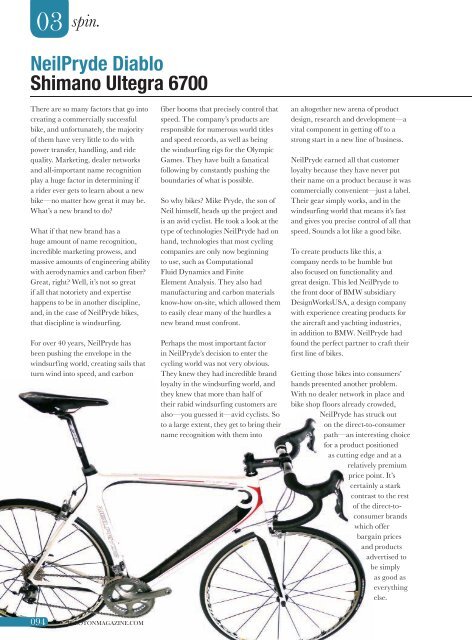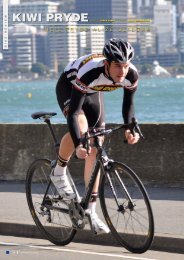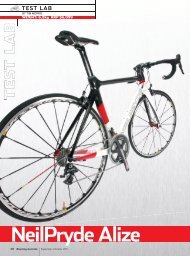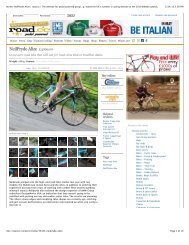NeilPryde Diablo Shimano Ultegra 6700 - NeilPryde Bikes
NeilPryde Diablo Shimano Ultegra 6700 - NeilPryde Bikes
NeilPryde Diablo Shimano Ultegra 6700 - NeilPryde Bikes
You also want an ePaper? Increase the reach of your titles
YUMPU automatically turns print PDFs into web optimized ePapers that Google loves.
03 spin.<br />
<strong>NeilPryde</strong> <strong>Diablo</strong><br />
<strong>Shimano</strong> <strong>Ultegra</strong> <strong>6700</strong><br />
There are so many factors that go into<br />
creating a commercially successful<br />
bike, and unfortunately, the majority<br />
of them have very little to do with<br />
power transfer, handling, and ride<br />
quality. Marketing, dealer networks<br />
and all-important name recognition<br />
play a huge factor in determining if<br />
a rider ever gets to learn about a new<br />
bike—no matter how great it may be.<br />
What’s a new brand to do?<br />
What if that new brand has a<br />
huge amount of name recognition,<br />
incredible marketing prowess, and<br />
massive amounts of engineering ability<br />
with aerodynamics and carbon fiber?<br />
Great, right? Well, it’s not so great<br />
if all that notoriety and expertise<br />
happens to be in another discipline,<br />
and, in the case of <strong>NeilPryde</strong> bikes,<br />
that discipline is windsurfing.<br />
For over 40 years, <strong>NeilPryde</strong> has<br />
been pushing the envelope in the<br />
windsurfing world, creating sails that<br />
turn wind into speed, and carbon<br />
fiber booms that precisely control that<br />
speed. The company’s products are<br />
responsible for numerous world titles<br />
and speed records, as well as being<br />
the windsurfing rigs for the Olympic<br />
Games. They have built a fanatical<br />
following by constantly pushing the<br />
boundaries of what is possible.<br />
So why bikes? Mike Pryde, the son of<br />
Neil himself, heads up the project and<br />
is an avid cyclist. He took a look at the<br />
type of technologies <strong>NeilPryde</strong> had on<br />
hand, technologies that most cycling<br />
companies are only now beginning<br />
to use, such as Computational<br />
Fluid Dynamics and Finite<br />
Element Analysis. They also had<br />
manufacturing and carbon materials<br />
know-how on-site, which allowed them<br />
to easily clear many of the hurdles a<br />
new brand must confront.<br />
Perhaps the most important factor<br />
in <strong>NeilPryde</strong>’s decision to enter the<br />
cycling world was not very obvious.<br />
They knew they had incredible brand<br />
loyalty in the windsurfing world, and<br />
they knew that more than half of<br />
their rabid windsurfing customers are<br />
also—you guessed it—avid cyclists. So<br />
to a large extent, they get to bring their<br />
name recognition with them into<br />
an altogether new arena of product<br />
design, research and development—a<br />
vital component in getting off to a<br />
strong start in a new line of business.<br />
<strong>NeilPryde</strong> earned all that customer<br />
loyalty because they have never put<br />
their name on a product because it was<br />
commercially convenient—just a label.<br />
Their gear simply works, and in the<br />
windsurfing world that means it’s fast<br />
and gives you precise control of all that<br />
speed. Sounds a lot like a good bike.<br />
To create products like this, a<br />
company needs to be humble but<br />
also focused on functionality and<br />
great design. This led <strong>NeilPryde</strong> to<br />
the front door of BMW subsidiary<br />
DesignWorksUSA, a design company<br />
with experience creating products for<br />
the aircraft and yachting industries,<br />
in addition to BMW. <strong>NeilPryde</strong> had<br />
found the perfect partner to craft their<br />
first line of bikes.<br />
Getting those bikes into consumers’<br />
hands presented another problem.<br />
With no dealer network in place and<br />
bike shop floors already crowded,<br />
<strong>NeilPryde</strong> has struck out<br />
on the direct-to-consumer<br />
path—an interesting choice<br />
for a product positioned<br />
as cutting edge and at a<br />
relatively premium<br />
price point. It’s<br />
certainly a stark<br />
contrast to the rest<br />
of the direct-toconsumer<br />
brands<br />
which offer<br />
bargain prices<br />
and products<br />
advertised to<br />
be simply<br />
as good as<br />
everything<br />
else.<br />
094 ••• PELOTONMAGAZINE.COM
The Process. Offering two bikes<br />
for their first product year, the Alize<br />
and the <strong>Diablo</strong>, we were given our<br />
choice of test bike. While both bikes<br />
share the same geometry they have<br />
radically different tube shapes and<br />
layup. The Alize is designed as an<br />
aero bike with some comfort built into<br />
the ride. The <strong>Diablo</strong> is slightly lighter<br />
with tube shapes designed to deliver<br />
incredible stiffness and real road<br />
racing credentials.<br />
Since a trip to the bike shop won’t<br />
do you any good when buying a<br />
<strong>NeilPryde</strong>, our test began with a trip<br />
to www.<strong>NeilPryde</strong><strong>Bikes</strong>.com. As big<br />
fans of stiff race bikes, we decided to<br />
go with the <strong>Diablo</strong> and used the site’s<br />
built-in fit calculator to choose a size.<br />
An easy-to-navigate interface<br />
allows you to enter your height and<br />
inseam, and then using the “Lemond<br />
Formulas,” a bike size is suggested<br />
with all the critical measurements<br />
clearly displayed. Any rider can be<br />
confident in this system’s ability to<br />
provide the correct size frame; any<br />
fine adjustments are easily handled by<br />
saddle height and stem adjustments.<br />
Our XL <strong>Diablo</strong> arrived essentially<br />
ready to ride. Carefully packed in<br />
heaps of foam and paper, the bike<br />
was unblemished and only the bars,<br />
saddle and front wheel needed to be<br />
installed. Just about anybody with the<br />
skills to change a flat tire can have the<br />
bike built and ready to ride within 15<br />
minutes of opening the box.<br />
<strong>NeilPryde</strong> includes all taxes, import<br />
duties, and shipping in its pricing, so<br />
you will never be surprised by what<br />
the bike actually end up costing.<br />
In the case of our <strong>Diablo</strong> outfitted<br />
with Utegra <strong>6700</strong>, it’s $4,350 and<br />
that’s it. Additionally, to take much<br />
of the worry about buying direct to<br />
consumer out of the equation, Neil<br />
Pryde also gives its customers a sevenday,<br />
no-questions-asked return policy<br />
and a 10-year warranty.<br />
The <strong>Diablo</strong>. Aiming for a<br />
lightweight road-racing machine<br />
with great power transfer, the <strong>Diablo</strong><br />
utilizes very complicated tube<br />
shapes to make this happen. Most<br />
notable in the design is something<br />
<strong>NeilPryde</strong> calls Exoskeleton<br />
technology. It is a pronounced ridge<br />
that runs uninterrupted along the<br />
top tube, down the head tube and<br />
back along the down tube to the<br />
bottom bracket. Created using Finite<br />
Element Analysis, the ridge uses<br />
uninterrupted unidirectional carbon<br />
fibers throughout the monocoque<br />
front triangle.<br />
This same ridged concept is echoed<br />
in the straight blade forks and<br />
both sets of stays, with robust ribs<br />
designed into the seat cluster and the<br />
bottom bracket. With an enormously<br />
tall and aggressively peaked down<br />
tube—which is mirrored by the top<br />
tube shape—the <strong>Diablo</strong>’s striking<br />
forms suggest some incredible power<br />
transfer and even hints at a lack of<br />
vertical compliance.<br />
A tapered steer tube resides within<br />
an extremely robust head tube.<br />
Integrating seamlessly into the<br />
straight blade forks, its flattened<br />
front section is one of the bike’s<br />
most striking features. And again, it<br />
speaks to some incredible stiffness.<br />
In fact, the only nod to compliance<br />
apparent on the bike at first glance<br />
is a traditional, round 27.2 seat post.<br />
It does, however, get a slick rubber<br />
grommet to give the post quite an<br />
integrated appearance.<br />
While the stated goal of stiffness is<br />
apparent in every tube shape, the goal<br />
of light weight my not have been as<br />
successfully met. While the advertised<br />
weight for a 56cm frame is less than<br />
1,000 grams, at 970 grams this is not<br />
within 100 grams of what is truly<br />
considered a lightweight frame these<br />
days. Of course, frame weight is only<br />
one barometer, and, in many cases,<br />
rather misleading. What matters is<br />
overall performance and that can<br />
only be judged with long miles over<br />
varied terrain.
The Ride. With <strong>NeilPryde</strong> using<br />
the same geometry for both bikes,<br />
our initial concern was angles that<br />
would deliver a middle-of-the-road,<br />
pedestrian feel. We were happy to<br />
see a tight wheelbase with fairly steep<br />
and short head tubes. The short chain<br />
stays add to this performance-oriented<br />
layout by tucking the wheel right up<br />
against the seat tube.<br />
The <strong>Diablo</strong> delivers truth in<br />
advertising. It is stiff. Every pedaling<br />
input is greeted with an incredibly<br />
rigid platform. The bike wants to go,<br />
go, go. It was the prefect ride as we<br />
upped the intensity on our long base<br />
miles. With a big helping of intervals<br />
and sprint work thrown in the mix,<br />
the <strong>Diablo</strong> helped us feel a little<br />
better about ourselves, as our meager<br />
January power numbers delivered<br />
more speed than they deserved thanks<br />
to the bike. The bike inspires you<br />
to keep on the power an extra few<br />
moments when climbing, and while<br />
sprinting, that city limit sign seems to<br />
rush up a few moments sooner.<br />
The stiffness does not end with the<br />
bottom bracket and chain stays. The<br />
front of the bike may be the stiffest we<br />
have ever ridden. There is nothing<br />
vague about the way this bike dives<br />
into a corner. Carve the fastest,<br />
tightest line you can imagine and the<br />
bike is still ready to dive under your<br />
riding buddies and get you out of the<br />
saddle a split second sooner as you<br />
rocket out of the turn.<br />
That stiffness, however, is apparent in<br />
every aspect of the bike’s performance.<br />
Over anything but the smoothest<br />
tarmac, the front end of the bike<br />
transmits every nook and cranny<br />
directly to the rider. It seems as though<br />
the straight blade forks are as stiff front<br />
to back as they are side to side. The<br />
tapered steer tube then delivers any<br />
impact to the head tube. Thanks to<br />
the incredibly tall cross section of the<br />
down tube and top tube, any front-toback<br />
compliance is nonexistent.<br />
The rear end of the bike is not quite<br />
as harsh, thanks mainly to the round<br />
27.2 carbon FSA post. It does an<br />
admirable job of isolating your body<br />
from the stiff stays. As stiff as the<br />
stays are, they are still not as stiff as<br />
the front end, which leads to another<br />
issue. While cornering on the edge,<br />
over less-than-perfect tarmac, the<br />
front and rear of the bike don’t<br />
react to impacts in a balanced, wellmannered<br />
way. The front feels more<br />
compelled to skip out while the rear<br />
tracks its line a little more consistently.<br />
The <strong>Diablo</strong> is a great example of why<br />
bikes need to be tested over the long<br />
term—tested over multiple types of<br />
terrain, in multiple types of riding<br />
situations. The reality is that a <strong>Diablo</strong>,<br />
while certainly stiff, is an absolute<br />
rocket ship over smooth road. It begs<br />
you to push your self further, whether<br />
it’s the line you carve or the power<br />
you put out. Its shortcomings only<br />
truly rear their head in very specific<br />
situations. Fast descending in a tight<br />
group over rough road can lead to<br />
some uncertain moments. Diving into<br />
a corner and encountering a rough<br />
gutter edge or an unfortunately placed<br />
pothole can put your heart in your<br />
throat. In those situations the bike<br />
requires a steady, confident hand.<br />
The Rider. You want stiff, you<br />
want fast and you want it in a very<br />
handsome package. Intervals and<br />
sprint workouts are a big part of your<br />
program and you want a bike that<br />
makes the most of your effort. You pay<br />
your tax dollars and your community<br />
fills those potholes and sweeps up that<br />
gravel. You’re not concerned by a bike<br />
that earns its name, <strong>Diablo</strong>, in rough,<br />
tight corners. ]p[<br />
The<br />
Bottom Line.<br />
neilprydebikes.com<br />
PRICE: $4,800 (as shown);<br />
$4,350 [on website]; $3,000<br />
(frame and fork)<br />
GROUP: <strong>Shimano</strong> <strong>Ultegra</strong> <strong>6700</strong><br />
WHEELSET: Mavic Ksyrium Elite<br />
OTHER: FSA seat post, stem,<br />
and handlebars<br />
WEIGHT: 16.10 lbs. with bottle<br />
cages and pedals<br />
096 ••• PELOTONMAGAZINE.COM






